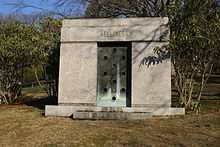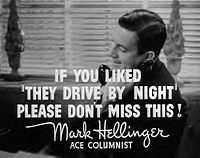Mark Hellinger
| Mark Hellinger | |
|---|---|
|
Hellinger in the trailer for High Sierra, one of several films he produced in the 1940s | |
| Born |
Mark Hellinger March 21, 1903 New York City |
| Died |
December 21, 1947 (aged 44) Los Angeles |
Cause of death | Coronary thrombosis |
Resting place |
Sleepy Hollow Cemetery Sleepy Hollow, New York |
| Citizenship | United States |
| Occupation |
Journalist Theatre columnist Film producer |
| Years active | 1923 - 1947 |
| Spouse(s) | Gladys Glad |
| Awards | Edgar Award for Best Motion Picture |
Mark Hellinger (March 21, 1903 - December 21, 1947) was an American journalist, theatre columnist and film producer.
Early life and career
Hellinger was born into an Orthodox Jewish family in New York City, although in later life he became a non-practicing Jew. When he was fifteen, he organized a student strike at Townsend Harris High School and was expelled for his actions. This proved to be the end of his formal education.[1]
In 1921, Hellinger began working as a waiter and cashier at a Greenwich Village night club in order to meet theatre people. He later was employed by Lane Bryant to write direct mail advertising for clothing for overweight and pregnant women. The following year he began his journalistic career as a reporter for Zit's Weekly, a theatrical publication, where he remained for eighteen months.[1]
In 1923, Hellinger moved to the city desk of the New York Daily News. In July 1925, he was assigned About Town, a Sunday column his editors intended him to fill with news and gossip about Broadway theatre. Instead, he filled the space with short stories in the style of O. Henry. When his columns drew a considerable amount of fan mail, he was permitted to continue in this vein. Three years later he graduated to a daily feature called Behind the News. He numbered such personalities as Walter Winchell, Florenz Ziegfeld, Texas Guinan, Dutch Schultz, and Legs Diamond among his friends.[1]
In November 1929, Hellinger moved to the New York Daily Mirror. While continuing to write daily and Sunday columns, he contributed sketches to the Ziegfeld Follies, wrote plays, published magazine articles, produced two collections of short stories, Moon Over Broadway (1931) and The Ten Million (1934),[1] and co-wrote the screenplay for Broadway Bill with Robert Riskin.
Later career
By 1937, Hellinger was a syndicated columnist featured in 174 newspapers. That same year he was hired as a writer/producer by Jack Warner. He provided the story for the 1939 Jimmy Cagney/Raoul Walsh gangster film The Roaring Twenties, basing it on his own experiences during that decade. In his onscreen foreword to the film, he wrote:
It may come to pass that, at some distant date, we will be confronted with another period similar to the one depicted in this photoplay. If that happens, I pray that the events, as dramatized here, will be remembered. In this film, the characters are composites of people I knew, and the situations are those that actually occurred. Bitter or sweet, most memories become precious as the years move on. This film is a memory - and I am grateful for it.
Due to a congenital heart condition, Hellinger repeatedly was rejected for active service during World War II. Instead, he briefly worked as a war correspondent, writing human interest stories about the troops.[2]

Other Hollywood producer credits included They Drive by Night, High Sierra, Thank Your Lucky Stars, The Horn Blows at Midnight, Brute Force, The Two Mrs. Carrolls, and The Naked City, which he also narrated. The film was released several weeks after Hellinger's death, and in his review for the New York Times, Bosley Crowther called it "a virtual Hellinger column on film" and "his appropriate valedictory" and observed, "The late Mark Hellinger's personal romance with the City of New York was one of the most ecstatic love affairs of the modern day — at least, to his host of friends and readers who are skeptics regarding l'amour. Before he became a film producer and was still just a newspaper scribe, Mr. Hellinger went for Manhattan in a blissfully uninhibited way — for its sights and sounds and restless movements, its bizarre people and its equally bizarre smells. And he made quite a local reputation framing his fancies in flowery billets doux which stirred the hearts and the humors of readers of the tabloid press." [3]
Hellinger won the 1947 Edgar Award for Best Motion Picture for The Killers.
Personal life
In 1926, Hellinger was one of the judges for a beauty contest sponsored by the Daily News. The winner was Ziegfeld showgirl Gladys Glad, and on July 11, 1929, the two were wed. She divorced him in 1932, but after a year the two remarried on the same date as their original wedding, and they remained wed until his death from a coronary thrombosis in Cedars of Lebanon Hospital in Los Angeles. He was buried in a private mausoleum at Sleepy Hollow Cemetery in Sleepy Hollow, New York on Christmas Eve.[1]
Legacy
In January 1949, the 51st Street Theatre in Manhattan was renamed the Mark Hellinger Theatre in his honor. In 1989 the venue was converted into the Times Square Church.[4]
The Hellinger Award annually acknowledges the accomplishments of St. Bonaventure University's most promising young journalism student. It was established in 1960 by columnist Jim Bishop in memory of his mentor.[5] Bishop also wrote a biography of Hellinger entitled The Mark Hellinger Story: A Biography of Broadway and Hollywood.[2]
References
External links
- Mark Hellinger at the Internet Movie Database
- Mark Hellinger at the Internet Broadway Database
- Mark Hellinger at Find a Grave
- Mark Hellinger site at St. Bonaventure University
|
